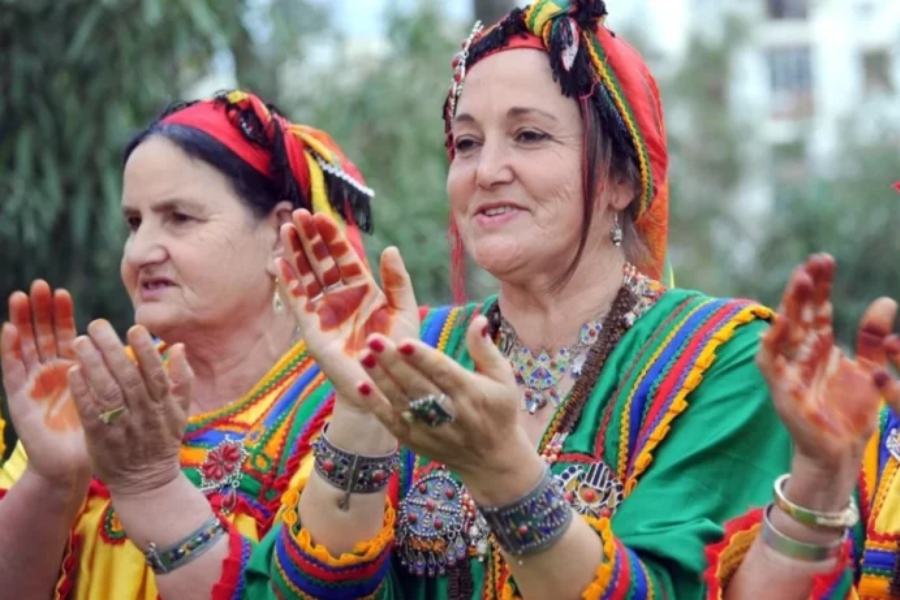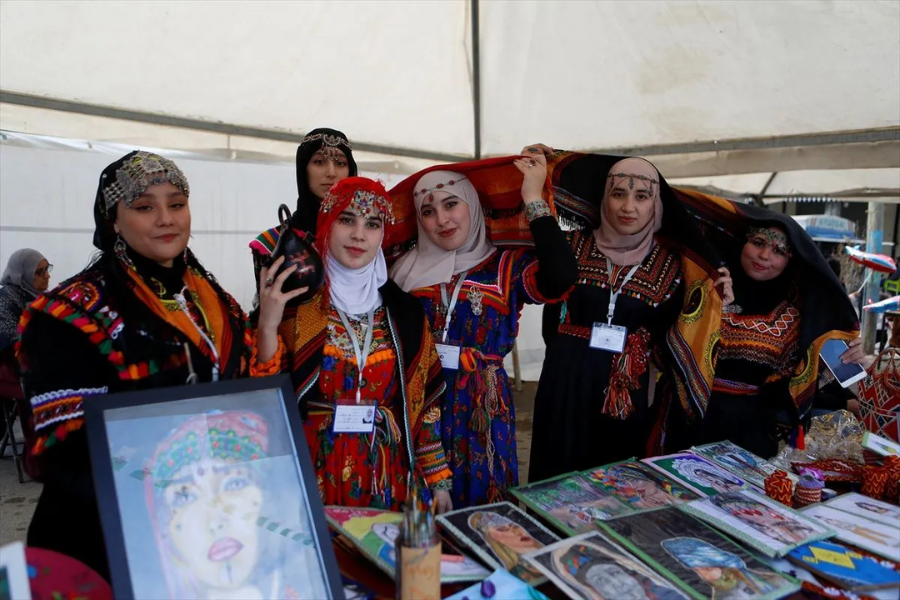The name “Amazigh” holds a huge social and strict load across the globe, interesting those anxious to look further into its rich history and lively customs.
In this far reaching article, we set out on a captivating excursion to enlighten the profundities of Amazigh culture, inseparable from Berber legacy, to give a reasonable and thorough comprehension for all.
As we dig into the complicated embroidery of Amazigh culture, we will reveal its verifiable roots, geographic dispersion, social character, strict variety, and contemporary importance.
Go along with us as we investigate the lively social mosaic that is the Amazigh public, encouraging a more profound appreciation and comprehension of their persevering through heritage.
Historical Background
The Amazigh public, otherwise called Berbers, are native to North Africa and have a set of experiences that traverses millennia.
Their impact is profoundly imbued in the locale’s way of life, with a heritage that incorporates a different blend of dialects, customs, and stories.
From old times, the Amazigh have been known as versatile and creative, exploring through different verifiable periods and outside impacts.
Their way of life, described by various dialects and rich oral customs, grandstands the strength and versatility of a constantly molded group and has been formed by the district’s social scene.
Geographic Distribution
The Amazigh public are principally tracked down in North Africa, with huge populations in Algeria, Tunisia, Libya, Mali, Niger, and Burkina Faso.
Over centuries, they have established a socially rich and different climate in these districts, leaving an extremely durable engraving on the scenes and nearby networks.
Their normal language, customs, and ceremonies tie these networks, upgrading the social texture of North African nations.
Notwithstanding the distinctions among these countries, the Amazigh culture fills in as a bringing together string, interfacing and fortifying the locale’s different social orders.
Cultural Identity
The Amazigh public, who additionally allude to themselves as Imazighen, encapsulate the beliefs of freedom and pride.
The expression “Imazighen” represents respectability and opportunity, mirroring the local area’s authentic protection from outside powers and their constancy in keeping up with their exceptional personality.
This common personality encourages a significant feeling of association and versatility among the Amazigh, guaranteeing the protection of their social legacy for people in the future.
Regardless of different difficulties, their social personality stays dynamic and indispensable to their lifestyle.
Religious Diversity
The strict scene of the Amazigh public is essentially as different as their social foundation. Before the appearance of Islam, the Berbers rehearsed different native religions, each with its own arrangement of customs and customs.
The spread of Islam in North Africa prompted the far reaching change of the Amazigh, with the greater part becoming Sunni Muslims.
Nonetheless, the strict personality of the Amazigh is perplexing, for certain disciples following the Shia part of Islam.
This variety mirrors the more extensive social and verifiable impacts that have molded the Amazigh nation over hundreds of years.
Contemporary Significance
In contemporary times, the meaning of the Amazigh culture stretches out past its exacting significance.
It encapsulates a lifestyle that celebrates ethnic variety and narrating customs.
Understanding the complexities of Amazigh culture gives significant bits of knowledge into the world’s social embroidered artwork, encouraging sympathy and appreciation for various civilizations.
The expression “Amazigh” goes about as an extension that interfaces individuals across ethnicities, empowering a more profound comprehension and regard for one another’s special encounters and legacy.
Family and Community
One of the most distinctive highlights of Amazigh culture is serious areas of strength for them of local area and family ties.
Family values hold unprecedented importance, with more distant families frequently living respectively and really focusing on one another.
Regard for elderly folks is profoundly implanted in their way of life, with more seasoned people being exceptionally adored for their insight and encounters.
Music, Dance, and Festivities

Music and dance assume a basic part in Amazigh culture. Customary instruments, for example, drums and woodwinds are utilized during festivities and celebrations, which are fundamental occasions for uniting networks.
These get-togethers commend their common legacy through music, dance exhibitions, narrating meetings, and customary games.
The Amazigh public likewise have a significant association with nature, frequently driving a semi-traveling way of life where they move with their domesticated animals along old shipping lanes.
This cozy relationship with nature has driven them to foster manageable practices, for example, patio cultivating procedures that permit them to develop crops on steep mountain slants.
Art and Craftsmanship
Imaginative articulation is one more basic part of Amazigh culture.
From complicatedly planned materials to bright ceramics, their craftsmanship is a demonstration of their social legacy and assumes a significant part in protecting their personality.
Customs, Traditions, and Beliefs
The traditions, customs, and convictions of the Amazigh public are well established in their day to day routines and have been passed down for ages.
Family social affairs for feasts are huge, giving chances to holding and oral narrating.
Tattoos hold exceptional importance in Amazigh culture, representing strength, fortitude, and magnificence. For ladies, tattoos are likewise viewed as an indication of fruitfulness.
Music is a noticeable practice, with conventional instruments like the “gimbri,” like a guitar, being key to their festivals.
Cover winding around is one more custom that holds profound social significance, with each plan recounting a story or addressing a particular clan or locale.
Language and Literature
The Amazigh public have a rich social legacy based on their language, writing, and craftsmanship.
Notwithstanding confronting concealment, their language, Tamazight, has endured as an image of their personality.
Oral narrating, particularly as verse, makes light of a critical job in passing customs and values.
Conclusion
Eventually, the social acts of the Amazigh public exhibit the flexibility and variety of human culture.
By investigating their set of experiences, geology, character, and strict practices, we gain a more profound comprehension of the perplexing Berber inheritance.
Embracing and fathoming Amazigh culture enhances our insight into mankind’s common history and makes ready towards a more comprehensive future.
Facts
- Historical Legacy: The Amazigh people, also known as Berbers, are indigenous to North Africa and have a history that spans millennia. Their influence is deeply embedded in the region’s culture.
- Geographic Distribution: The Amazigh people are primarily found in North Africa, with significant populations in Algeria, Tunisia, Libya, Mali, Niger, and Burkina Faso.
- Cultural Identity: The Amazigh people refer to themselves as Imazighen, symbolizing nobility and freedom. Their identity is characterized by resilience and pride in their unique heritage.
- Religious Diversity: Before Islam, the Berbers practiced various indigenous religions. Today, the majority are Sunni Muslims, with some following the Shia branch of Islam.
- Family and Community: Family values and community ties are central to Amazigh culture. Extended families often live together, and respect for elders is deeply ingrained.
- Music and Dance: Traditional music and dance play a vital role in Amazigh culture. Celebrations and festivals feature instruments like drums and woodwinds, bringing communities together.
- Art and Craftsmanship: Amazigh art includes intricately designed textiles and colorful pottery, reflecting their cultural heritage and craftsmanship.
- Language and Literature: The Amazigh language, Tamazight, has persisted despite suppression. Oral storytelling, especially poetry, is crucial in preserving traditions.
Summary:
The Amazigh people, indigenous to North Africa, boast a rich cultural heritage spanning millennia. Known for their resilience and adaptability, they have left an indelible mark on the region’s history and culture. Spread across countries like Algeria, Tunisia, and Libya, the Amazigh people, or Imazighen, symbolize nobility and freedom. Their cultural identity is strengthened by strong family values, community ties, and respect for elders. Traditional music, dance, and festivals are central to their communal life. Despite facing historical suppression, their language, Tamazight, and artistic expressions like textiles and pottery remain vital in preserving their heritage. The Amazigh people practice a diverse range of religions, with the majority being Sunni Muslims. Their customs and traditions, deeply rooted in their daily lives, highlight their unique cultural identity and contribute significantly to the rich tapestry of human civilization.
FAQs:
What race is Amazigh?
The Amazigh people, also known as Berbers, encompass various ethnic groups including indigenous North Africans, Caucasoid peoples, and Mediterranean peoples, displaying a wide range of physical characteristics.
Are Algerians Arab?
While many Algerians identify as Arab, the country is home to a diverse population, including significant Berber (Amazigh) minorities. Most Algerians are of Arab-Berber descent due to historical intermingling.
Who are the original people of Morocco?
The Berbers (Amazigh) are the original inhabitants of Morocco, with a presence dating back thousands of years. They have significantly influenced the cultural fabric of the nation.
Are the Berbers Arab?
No, Berbers (Amazigh) and Arabs are distinct ethnic groups with unique identities. The Berbers have lived in North Africa long before the arrival of Arab settlers.
What is the significance of the term “Imazighen”?
“Imazighen” means “free people” or “noble people,” reflecting the Amazigh people’s historical resistance to external forces and their pride in their unique identity.
How has Islam influenced Amazigh culture?
Islam has significantly influenced Amazigh culture, with many Berbers adopting the religion while retaining aspects of their indigenous beliefs. Most Berbers are Sunni Muslims.
Where do the Amazigh people predominantly reside?
The Amazigh people primarily reside in North Africa, particularly in Algeria, Tunisia, Libya, Mali, Niger, and Burkina Faso.
What distinguishes Amazigh culture from other cultural identities?
Amazigh culture is distinguished by its rich storytelling traditions, diverse linguistic heritage, strong family values, and deep connection to the land.
How does learning about Amazigh culture contribute to global understanding?
Exploring Amazigh culture enhances empathy and appreciation for different civilizations, deepening our knowledge of humanity’s shared history and promoting global inclusivity.

Leave a Reply